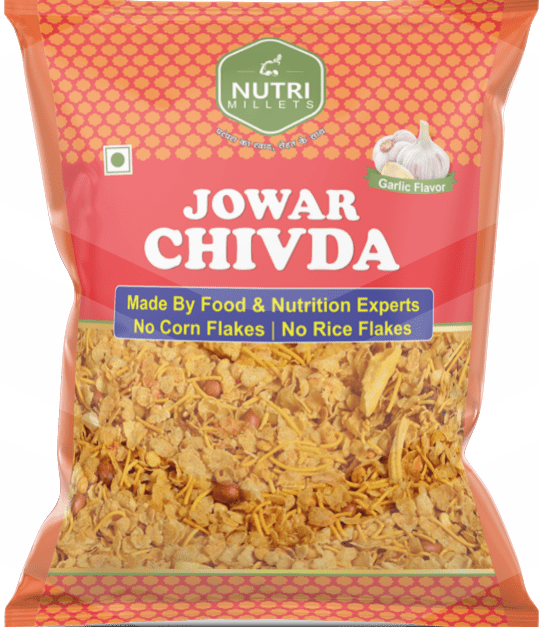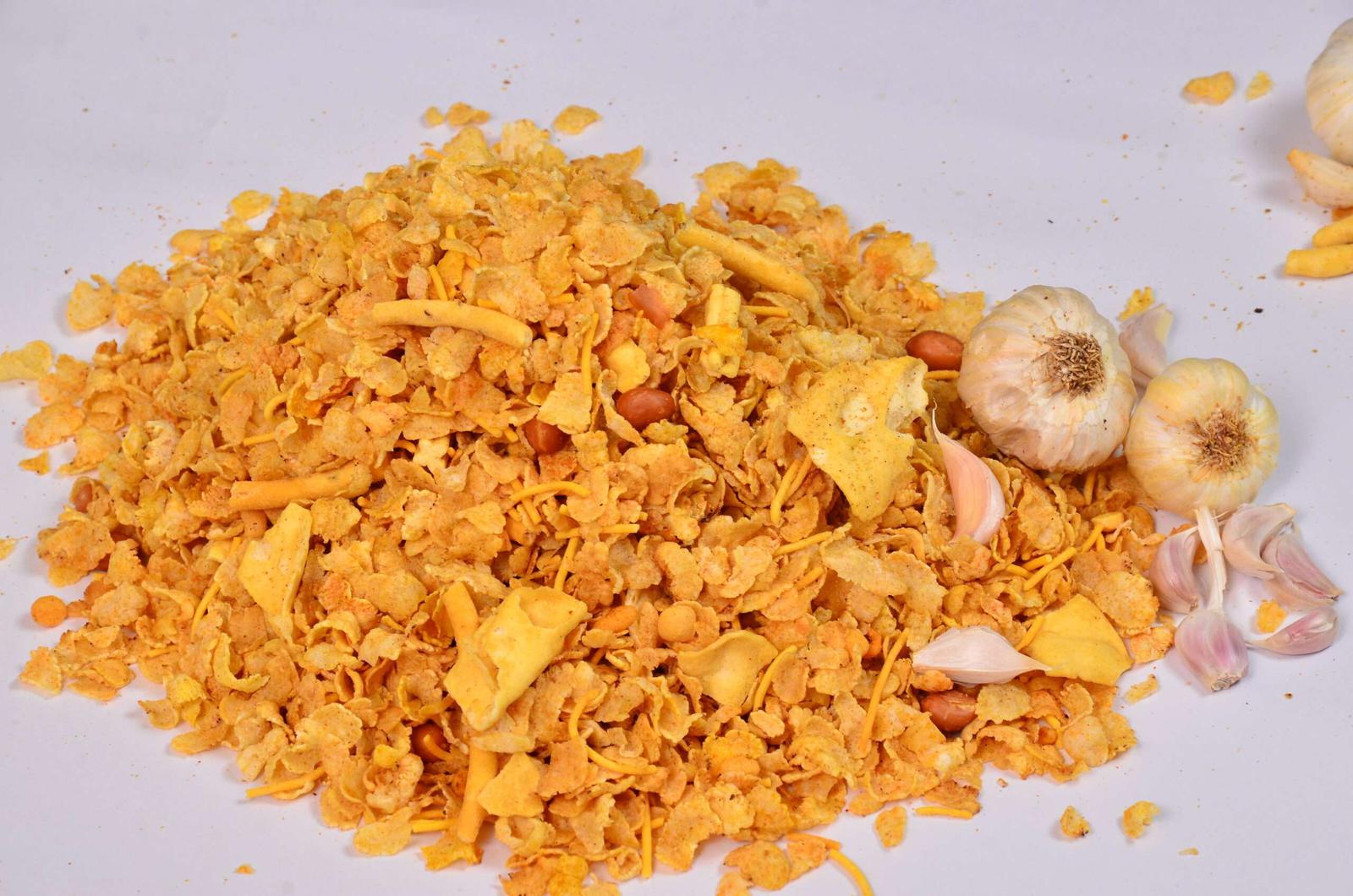Nutrimillets Namkeen – Jowar Chivda – Garlic Flavor (100 grams)
₹40.0 / Grams
Specifications
Packing – 100g
Price – Rs.40/-
Shelf life – 6 Months
| Nutritional Facts | Per 100g |
| Calories (Kcal) | 548.2 |
| Total Fats (%) | 29.2 |
| Total Carbohydrates (%) | 47.18 |
| Dietary Fiber (%) | 6.75 |
| Protein (%) | 10.01 |
- Description
- Additional information
- Reviews (0)
- Q & A
- Sustainability Remark
- More Offers
- Store Policies
- Inquiries
Nutri millets garlic chivda:
In the realm of breakfast and snacks, a noteworthy shift towards healthier alternatives is embodied by the rise of millet-based food products. Transitioning from traditional grains, millets emerge as nutritional powerhouses, reshaping the food landscape.
To commence, millets, a diverse group of small-seeded grasses, serve as the foundation for a myriad of breakfast and snack options. From millet porridge to granola bars, these products offer a delectable fusion of taste and health benefits.
Transitioning from conventional cereal grains, millets boast a rich nutritional profile. Packed with essential nutrients like fiber, vitamins, and minerals, they contribute to overall well-being and aid in combating lifestyle-related diseases.
The versatility of millets in snack preparation is noteworthy. Millet-based snacks, such as baked millet chips or millet-based energy bars, cater to the growing demand for on-the-go, nutritious alternatives. These snacks are not only convenient but also satiate cravings without compromising health.
Moreover, millet products align with the trend of gluten-free and allergen-friendly options. They cater to individuals with dietary restrictions, offering a wholesome alternative that doesn’t compromise on taste or nutritional value.
The benefits extend beyond personal health; millet cultivation promotes sustainable agriculture. These hardy crops require less water and are well-adapted to diverse agroecological zones, contributing to water conservation and soil health.
Nutri millets garlic chivda: As consumer awareness grows, the food industry responds with innovative millet-based products. Breakfast cereals, muffins, and even millet-based pasta are becoming staples, offering a delightful departure from traditional breakfast and snack choices.
In conclusion, the elevation of millet-based food products in the breakfast and snacks domain signifies a shift towards holistic well-being and sustainable food choices. The amalgamation of nutritional benefits, versatility, and environmental sustainability positions millets as a transformative force in shaping the future of breakfast and snack options.
| Weight | 0.1 kg |
|---|
You must be logged in to post a review.
Q & A
1. Sustainable Ingredients:
- Jowar (Sorghum): Jowar is a drought-resistant crop that requires less water compared to other grains like rice and wheat. This reduces the overall water footprint of the product. Additionally, sorghum is often grown in dry regions where it contributes to soil conservation by preventing erosion.
- Garlic: Garlic is a relatively low-impact crop in terms of resource use. It grows quickly, requires minimal water, and has a natural resistance to pests, reducing the need for chemical pesticides.
- The production of Jowar Chivda typically involves simple processes like roasting, seasoning, and minimal frying. This low level of processing reduces the energy consumption associated with production, contributing to a lower environmental impact.
- If the ingredients for the Namkeen are sourced locally, it reduces the transportation-related carbon emissions. Local sourcing also supports local economies and reduces the environmental impact associated with long-distance transportation.
Carbon Footprint of Namkeen – Jowar Chivda – Garlic Flavor
1. Energy-Efficient Production:- The production process of this product is energy-efficient due to the minimal use of heat treatment (roasting or light frying). This limits the carbon emissions associated with cooking and processing.
- If the product uses minimal and eco-friendly packaging, such as biodegradable or recyclable materials, it reduces the carbon footprint associated with plastic waste and packaging production.
- Jowar cultivation is associated with lower greenhouse gas emissions compared to other grains, mainly due to its ability to grow in marginal lands with minimal inputs. This reduces the overall carbon footprint of the raw material.
- If the production facility utilizes renewable energy sources, such as solar or wind energy, it further reduces the carbon footprint of the product.
Scientific Explanation
1. Drought Resistance and Low Water Use:- Scientific studies have shown that sorghum, the primary ingredient, has a lower water footprint compared to other staple crops. This is due to its C4 photosynthetic pathway, which is more efficient in water usage, particularly in semi-arid regions .
- Sorghum roots contribute to soil carbon sequestration by enhancing soil organic matter, which is crucial for maintaining soil health and reducing atmospheric CO2 levels. This practice is recognized in regenerative agriculture, which is linked to reduced carbon footprints .
- Garlic cultivation is associated with relatively low greenhouse gas emissions due to its low input requirements. Studies indicate that garlic has one of the lower carbon footprints among vegetables, especially when grown organically or with minimal synthetic inputs .
- Jowar's drought resistance and water efficiency: "Sorghum and Millets in Human Nutrition" - FAO
- Garlic's low-impact cultivation: "Life Cycle Assessment of Fresh Garlic: Environmental Impact Analysis of a Typical Italian Production Chain" - Journal of Cleaner Production.
- Carbon sequestration and soil health: "Carbon Sequestration in Agricultural Soils via Cultivation of Cover Crops" - Agronomy Journal.
General Inquiries
There are no inquiries yet.



















Reviews
There are no reviews yet.